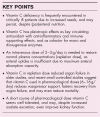Vitamin C: should we supplement?
- PMID: 29864039
- PMCID: PMC6039380
- DOI: 10.1097/MCC.0000000000000510
Vitamin C: should we supplement?
Abstract
Purpose of review: Hypovitaminosis C and vitamin C deficiency are very common in critically ill patients due to increased needs and decreased intake. Because vitamin C has pleiotropic functions, deficiency can aggravate the severity of illness and hamper recovery.
Recent findings: Vitamin C is a key circulating antioxidant with anti-inflammatory and immune-supporting effects, and a cofactor for important mono and dioxygenase enzymes. An increasing number of preclinical studies in trauma, ischemia/reperfusion, and sepsis models show that vitamin C administered at pharmacological doses attenuates oxidative stress and inflammation, and restores endothelial and organ function. Older studies showed less organ dysfunction when vitamin C was administered in repletion dose (2-3 g intravenous vitamin C/day). Recent small controlled studies using pharmacological doses (6-16 g/day) suggest that vitamin C reduces vasopressor support and organ dysfunction, and may even decrease mortality.
Summary: A short course of intravenous vitamin C in pharmacological dose seems a promising, well tolerated, and cheap adjuvant therapy to modulate the overwhelming oxidative stress in severe sepsis, trauma, and reperfusion after ischemia. Large randomized controlled trials are necessary to provide more evidence before wide-scale implementation can be recommended.
Figures



Similar articles
-
Hypovitaminosis C and vitamin C deficiency in critically ill patients despite recommended enteral and parenteral intakes.Crit Care. 2017 Dec 11;21(1):300. doi: 10.1186/s13054-017-1891-y. Crit Care. 2017. PMID: 29228951 Free PMC article.
-
Vitamin C revisited.Crit Care. 2014 Aug 6;18(4):460. doi: 10.1186/s13054-014-0460-x. Crit Care. 2014. PMID: 25185110 Free PMC article. Review.
-
Vitamin C requirements in parenteral nutrition.Gastroenterology. 2009 Nov;137(5 Suppl):S70-8. doi: 10.1053/j.gastro.2009.08.012. Gastroenterology. 2009. PMID: 19874953 Review.
-
Rationale and impact of vitamin C in clinical nutrition.Curr Opin Clin Nutr Metab Care. 2006 Nov;9(6):697-703. doi: 10.1097/01.mco.0000247478.79779.8f. Curr Opin Clin Nutr Metab Care. 2006. PMID: 17053422 Review.
-
Vitamin C supplementation in the critically ill patient.Curr Opin Clin Nutr Metab Care. 2015 Mar;18(2):193-201. doi: 10.1097/MCO.0000000000000148. Curr Opin Clin Nutr Metab Care. 2015. PMID: 25635594 Review.
Cited by
-
Mortality in septic patients treated with vitamin C: a systematic meta-analysis.Crit Care. 2021 Jan 6;25(1):17. doi: 10.1186/s13054-020-03438-9. Crit Care. 2021. PMID: 33407793 Free PMC article.
-
Targeting Oxidative Stress: The Potential of Vitamin C in Protecting against Liver Damage after Electron Beam Therapy.Biomedicines. 2024 Sep 26;12(10):2195. doi: 10.3390/biomedicines12102195. Biomedicines. 2024. PMID: 39457507 Free PMC article.
-
Association between Vitamin C Deficiency and Mortality in Patients with Septic Shock.Biomedicines. 2022 Aug 26;10(9):2090. doi: 10.3390/biomedicines10092090. Biomedicines. 2022. PMID: 36140190 Free PMC article.
-
Combination of Vitamin C and Curcumin Safeguards Against Methotrexate-Induced Acute Liver Injury in Mice by Synergistic Antioxidant Effects.Front Med (Lausanne). 2022 Apr 14;9:866343. doi: 10.3389/fmed.2022.866343. eCollection 2022. Front Med (Lausanne). 2022. PMID: 35492324 Free PMC article.
-
The Challenges and Effects of Ascorbic Acid Treatment of Acute Pancreatitis: A Systematic Review and Meta-Analysis of Preclinical and Clinical Studies.Front Nutr. 2021 Oct 26;8:734558. doi: 10.3389/fnut.2021.734558. eCollection 2021. Front Nutr. 2021. PMID: 34765629 Free PMC article.
References
-
- Amrein K, Oudemans-van Straaten HM, Berger MM. Vitamin therapy in critically ill patients: focus on thiamine, vitamin C, and vitamin D. Intensive Care Med 2018; doi: 10.1007/s00134-018-5107-y [Epub ahead of print]. - PMC - PubMed
-
A recent high-quality review of the studies in intensive care patients reporting vitamin C plasma levels and the controlled studies on the effect of vitamin C in critically ill patients.
-
- Carr AC, Rosengrave PC, Bayer S, et al. Hypovitaminosis C and vitamin C deficiency in critically ill patients despite recommended enteral and parenteral intakes. Crit Care 2017; 21:300. - PMC - PubMed
-
An important study describing hypovitaminosis C and vitamin C deficiency in critically ill patients.
-
- Rice ME, Lee EJ, Choy Y. High levels of ascorbic acid, not glutathione, in the CNS of anoxia-tolerant reptiles contrasted with levels in anoxia-intolerant species. J Neurochem 1995; 64:1790–1799. - PubMed
-
- Nakano K, Suzuki S. Stress-induced change in tissue levels of ascorbic acid and histamine in rats. J Nutr 1984; 114:1602–1608. - PubMed
Publication types
MeSH terms
Substances
LinkOut - more resources
Full Text Sources
Other Literature Sources
Medical
Research Materials

